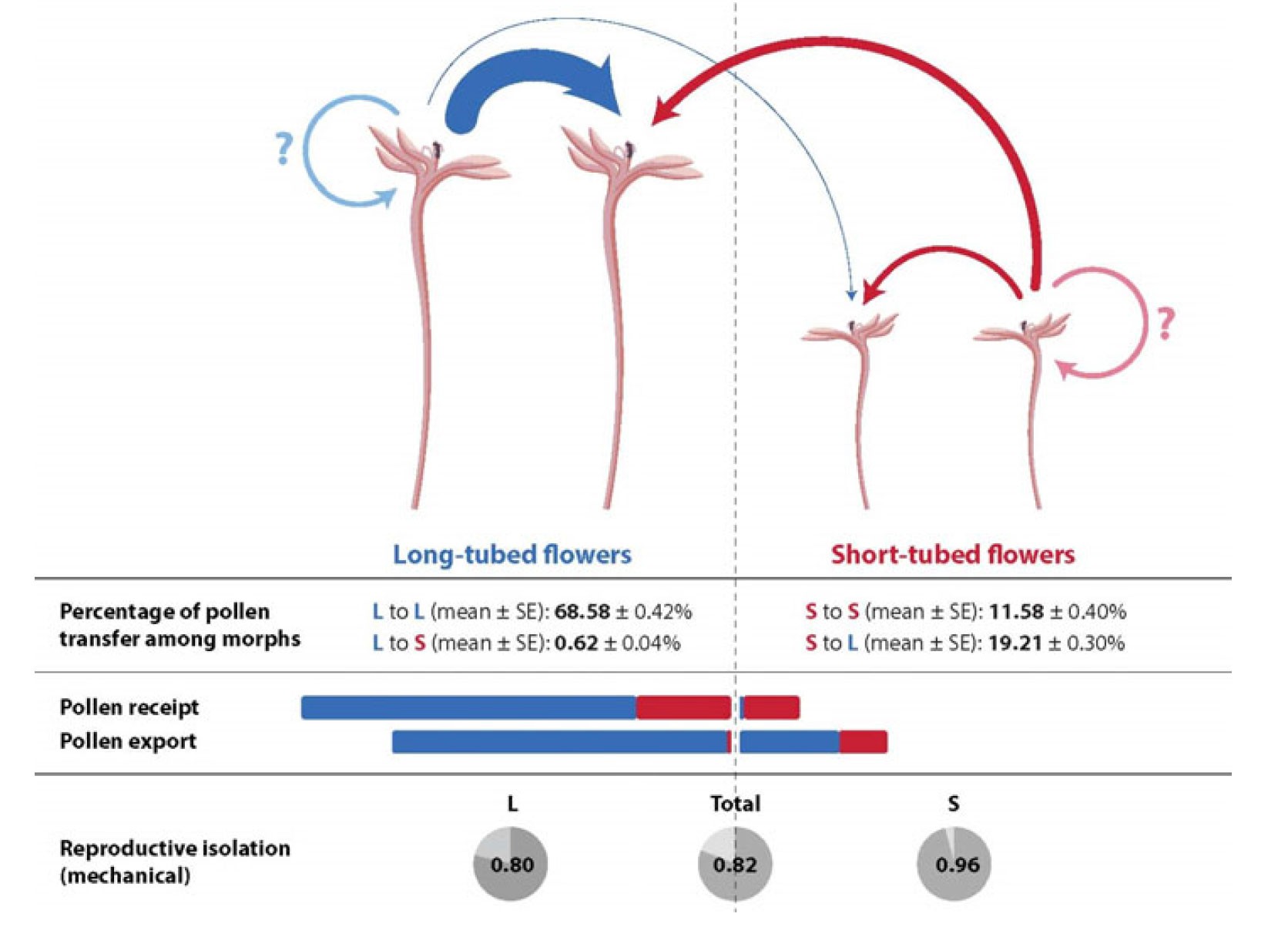博文
New Phytologist:鸢尾花种间花管长度分化促进生殖隔离
||
Intraspecific divergence in floral‐tube length promotes asymmetric pollen movement and reproductive isolation
First author: Corneile Minnaar; Affiliations: Stellenbosch University (斯泰伦博斯大学): Matieland, South Africa
Corresponding author: Bruce Anderson
The causative link between phenotypic divergence and reproductive isolation is an important but poorly understood part of ecological speciation. We studied the effects of floral‐tube length variation on pollen placement/receipt positions and reproductive isolation. In a population of Lapeirousia anceps (Iridaceae) with bimodal floral‐tube lengths, we labelled pollen of short‐ and long‐tubed flowers with different color fluorescent nano‐particles (quantum dots). This enabled us to map pollen placement by long‐ and short‐tubed flowers on the only floral visitor, a long‐proboscid fly. Furthermore, it allowed us to quantify pollen movement within and between floral‐tube lengths. Short‐ and long‐tubed flowers placed pollen on different parts of the pollinator, and long‐tubed flowers placed more pollen per visit than short‐tubed flowers. This resulted in assortative pollen receipt (most pollen received comes from the same phenotype) and strong but asymmetric reproductive isolation, where short‐tubed plants are more reproductively isolated than long‐tubed plants. These results suggest that floral‐tube length divergence can promote mechanical isolation in plants through divergence in pollen placement sites on pollinators. Consequently, in concert with other reproductive isolation mechanisms, selection for differences in floral‐tube length can play an important role in ecological speciation of plants.
表型分化与生殖隔离之间的关联是非常重要的,但有关这方面的研究却很少。作者研究了花管(托杯)长度变异对于花粉接受位置以及生殖隔离的影响。在鸢尾科植物Lapeirousia anceps一个群体中,主要有两种长度托杯的植株,作者通过不同的彩色荧光纳米颗粒(量子点)分别标记了长管和短管的花。这使得作者能够比较这两种花的花粉在唯一的访花昆虫长鼻蝇身上的来定位。此外,作者还可以通过这种方法来定量并比较这两种花管中花粉的移动。作者发现长筒和短筒花会将花粉置于穿粉者身上的不同部位,并且长筒花要比短筒花在每个访花者身上放置的花粉更多。这样会导致同配型花粉接受,即大多的花粉被授到了同样基因型的植株上,这样就形成了强烈的,但不对称的生殖隔离,其中,短筒花植株要比长筒花植株更加地被生殖隔离。这些结果说明花管长度的分化可以通过将花粉置于穿粉者身上的不同位置来促进植物的机械隔离。因此,与其它的生殖隔离机制一致,对于花管长度差异的选择对于植物的生态型物种形成具有重要的作用。
通讯:Bruce Anderson (http://www.biointeractionslab.com/prof.-bruce-anderson.html)
研究方向:动、植物对于环境的适应性和演化生态学。
doi: https://doi.org/10.1111/nph.15971
Journal: New Phytologist
Published date: May 30, 2019
https://blog.sciencenet.cn/blog-3158122-1183457.html
上一篇:Nature Plants:营养增强型GM作物所面临的挑战
下一篇:the plant journal:SNLs基因控制拟南芥在长、短日照下的成花转变
全部作者的其他最新博文
- • Plant Physiology:CsMADS3促进柑果中的叶绿素降解和类胡萝卜素合成(华中农业大学)
- • Molecular Plant:LBD11-ROS反馈调节作用于拟南芥的维管形成层增殖和次生生长(浦项科技大学)
- • Science Advances:根结线虫通过调控植物的CLE3-CLV1模块,促进侵染进程(日本熊本大学)
- • Nature Communications:油菜素内酯参与植物营养生长期转变的分子机制解析(浙江农林大学)
- • Current Biology:光合作用产生的蔗糖驱动侧根“生物钟”(德国弗莱堡大学)
- • PNAS:花同源异型基因在叶中被抑制、花中被激活的分子机制(南卡罗来纳大学)

